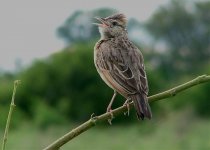Hi,
I just got back from a trip to South Africa, and there were some birds which I was unable to identify satisfactorily.
Here are the links to two of them:
These two were in the northeast part of the country, just east of Polokwane.
Spotted Flycatcher?
http://www.pbase.com/disx0d/image/132166245
No idea - someone suggested a Coucal
http://www.pbase.com/disx0d/image/132166252
There are also a couple of larks from the Kimberley area that I'd like confirmation on:
Rufous-naped Lark? (or Eastern Clapper Lark?)
http://www.pbase.com/disx0d/image/132105218
http://www.pbase.com/disx0d/image/132105207
Fawn-coloured Lark?
http://www.pbase.com/disx0d/image/132105203
and a Desert Cisticola?
http://www.pbase.com/disx0d/image/132103591
I have a lot more pictures from Ivy Safaris and Kruger Park to put up, and probably some more mystery birds. (In fact I know there is a sunbird that doesn't look like anything in the book). I'll post again when I get those up.
Feel free to peruse the rest of the gallery and correct me on any misidentifications.
Thanks!
Bryan
I just got back from a trip to South Africa, and there were some birds which I was unable to identify satisfactorily.
Here are the links to two of them:
These two were in the northeast part of the country, just east of Polokwane.
Spotted Flycatcher?
http://www.pbase.com/disx0d/image/132166245
No idea - someone suggested a Coucal
http://www.pbase.com/disx0d/image/132166252
There are also a couple of larks from the Kimberley area that I'd like confirmation on:
Rufous-naped Lark? (or Eastern Clapper Lark?)
http://www.pbase.com/disx0d/image/132105218
http://www.pbase.com/disx0d/image/132105207
Fawn-coloured Lark?
http://www.pbase.com/disx0d/image/132105203
and a Desert Cisticola?
http://www.pbase.com/disx0d/image/132103591
I have a lot more pictures from Ivy Safaris and Kruger Park to put up, and probably some more mystery birds. (In fact I know there is a sunbird that doesn't look like anything in the book). I'll post again when I get those up.
Feel free to peruse the rest of the gallery and correct me on any misidentifications.
Thanks!
Bryan




